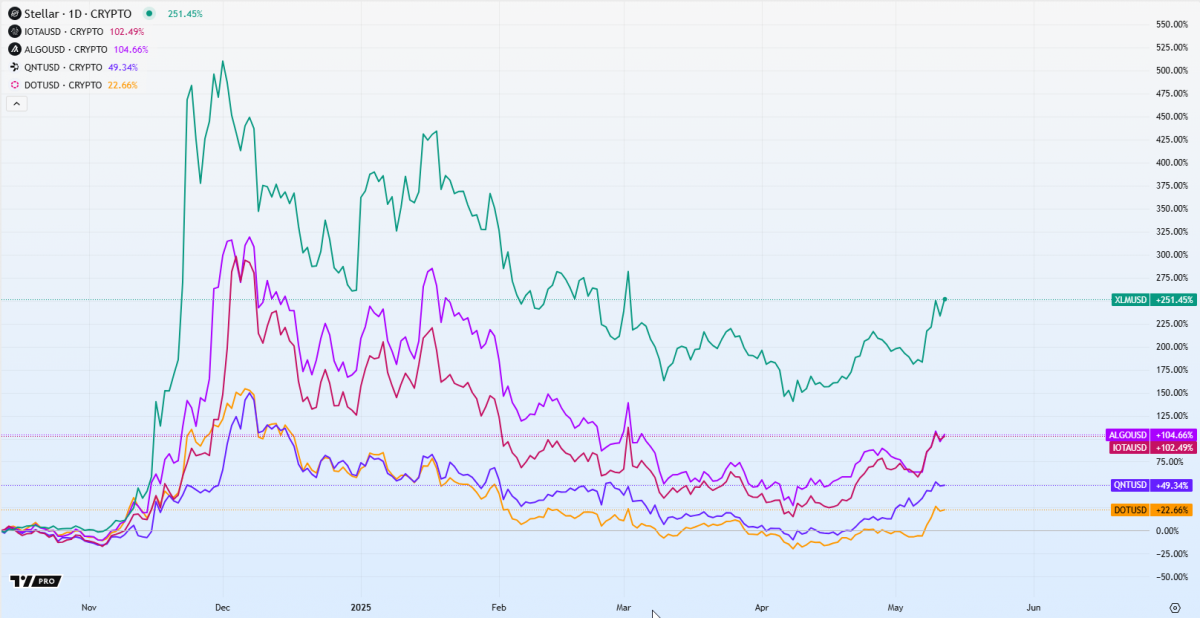With commercial space exploration and private space companies, a new question emerges: How can financial transactions be made between planets?
Due to communication delays and dependence on centralized institutions, traditional banking systems are unsuitable for interplanetary transactions. The solution lies in decentralized cryptocurrencies and blockchain technologies that can function even across cosmic distances.
Top 5 cryptocurrencies for interplanetary settlements
1. Stellar (XLM)
Fast and affordable interplanetary transactions.
- Operates on the SCP (Stellar Consensus Protocol), which doesn’t require intensive computing power.
- Supports the issuance of tokenized assets,e.g., “Martian dollars”, which in most cases correlate with the Ethereum price.
- Partners with IBM and other corporations to enhance its reliability for the space economy.
Stellar can process thousands of transactions per second with minimal delays, which is critical for communication between Earth and Mars.
2. IOTA (IOTA)
Decentralized transactions for space-based Internet of Things (IoT).
- Utilizes Tangle, an alternative to blockchain without fees and mining.
- Ideal for micropayments between satellites and spacecraft.
- Currently being developed for integration with space-based IoT devices.
Its infinite scalability and zero fees make IOTA ideal for automated transactions in space missions.
3. Algorand (ALGO)
Building sustainable financial infrastructure for space colonies.
- Uses pure Proof-of-Stake, which reduces power consumption.
- Instant transaction completion (under four seconds).
- Supports smart contracts to automate agreements in space.
Algorand offers the security and speed needed for interplanetary trade and resource management.
4. Quant (QNT)
Enabling communication between different blockchains in space.
- Overledger technology connects terrestrial and space-based blockchain networks.
- Provides secure data transmission between satellites and ground stations.
- Used in projects by the ESA (European Space Agency).
Quant addresses blockchain incompatibility, which is essential for creating a unified space economy.
5. Polkadot (DOT)
Creating an interplanetary blockchain ecosystem.
- Heterogeneous sharding enables interaction between different blockchains.
- High throughput — Polkadot processes thousands of transactions per second, which is vital for space infrastructure.
- Its relay chain ensures data protection when transferring between planets.
Polkadot solves blockchain network incompatibility and has the potential to build a unified financial system spanning the Earth, Moon, and Mars.

Blockchain in satellite communications and data management
Modern satellite systems face several challenges:
- Communication delays (signals between Earth and Mars can take 3 to 22 minutes).
- Vulnerability to hacker attacks.
- Dependence on centralized servers.
How does blockchain address these issues?
- Decentralized management – data is distributed across multiple satellites, reducing the risk of data loss.
- Security – cryptography protects data from hacking.
- Automation – smart contracts can control satellite functions without human intervention.
For example, Blockstream Satellite broadcasts Bitcoin transactions via satellite, providing access to cryptocurrency in remote areas. Traders and crypto enthusiasts can participate and monitor market conditions on charts and a crypto heatmap.
Digital art in the space industry
Space continues to inspire digital creators. Emerging trends include:
1. Generative space art
Artists use algorithms to generate images of galaxies, nebulae, and planets. These artworks are used in simulations, scientific visualization, and spacecraft design.
2. Virtual space exhibitions
Platforms like Decentraland (built on blockchain) host digital art exhibitions in virtual space stations.
3. Tokenization of space data
Some projects digitize authentic space images (for example, Hubble or JWST) and create collectible digital assets.
Blockchain and cryptocurrencies are becoming foundational technologies in the space economy. From interplanetary payments to satellite data security, decentralized solutions are opening new frontiers for humanity.

Disclaimer: The views expressed in this article are those of the author and may not reflect the views of the CryptoTotem team. This article is for informational purposes only and is not intended to be used as legal, tax, investment or financial advice. The author or the publication does not hold any responsibility, directly, or indirectly, for any damage or loss caused or alleged to be caused by or connected with the use of or reliance on any content, goods or services mentioned in this article. Readers should do their own research before taking any action on this matter.






